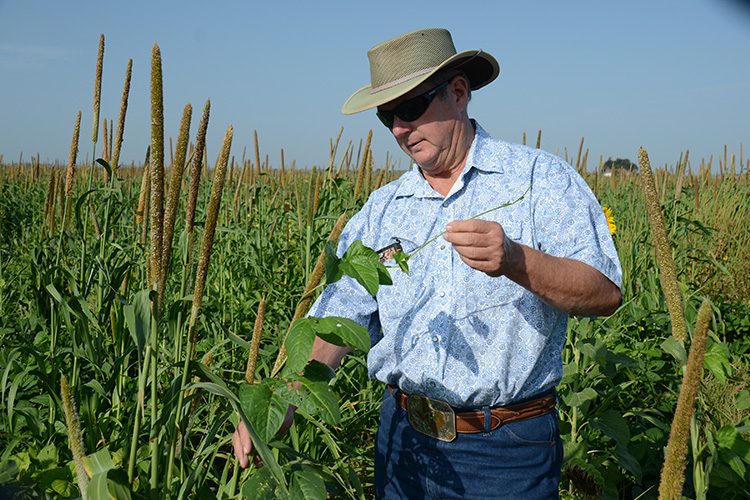Tommy Henderson inspects a cowpea vine that has grown up next to a millet plant. This vertical growth increases biomass and future organic material for the soil.
By Dee Ann Littlefield, NRCS Marketing Director/Public Affairs Specialist
Tommy Henderson says the wheat market is going to turn around. In fact he is banking on it. Not with his banker, but with his soil.
With the wheat futures market so low, the Byers, Texas, farmer doesn’t think he will plant wheat this fall. Instead, he is going to plant some cover crops that will nourish the soil and bank nutrients in his fields in the Red River Valley in north Texas.
Despite low grain prices, this 40-year veteran wheat farmer remains relatively optimistic. He knows farming is more than just annual profits and losses — it’s a long term investment. And that’s his plan for the coming year — he is investing in his soil.
“The wheat market is so bad that right now I'm focusing on improving my soil so when the market turns around my fields are prepared and my soil is healthy,” Henderson says.
Armed with an agronomy degree from Texas A&M University, Henderson has been experimenting with different crops and tillage techniques in his fields over the years. Henderson operates around 3,200 acres, with 2,000 of that being cropland, alongside his son, Charlie, and father, Bill. In 2009, the trio enrolled their operations in the Conservation Stewardship Program (CSP) through the USDA-NRCS, representing three generations of Hendersons taking conservation efforts to the next level.
“We had been wanting to go no-till for a long time,” Henderson says. “CSP provided the avenue for us to purchase the no-till machinery to switch our whole operation over to no till.
“It felt pretty good getting all that iron out of my soil.”
Henderson owns some of his production land, but leases the majority of it. It was important to him that his landlords understood the benefits of going no-till. He took each one of them out into their fields and explained the process to them and how this farming method could help improve their land over time without affecting their yields. They were all sold on the idea so Henderson moved out on his plan.
Transitioning fields from conventional tillage to no-till is a long-term process. However, Henderson began to see immediate results from the beginning. His soils became mellower with the increased organic matter. Then he began planting cover crops and soon saw how much they helped shade and protect the soil, and help retain soil moisture, which was especially important during the critical drought in 2011.
For the past 8 years, Henderson has planted cover crops of guar and mung beans, sesame, cow peas, sunflowers and millet, just to name a few. Each one plays a key role in depositing nutrients in the soil with the additional benefit of providing excellent pollinator habitat, which is also advantageous for the crops. Henderson currently has a cash cover crop of guar that is thriving in a field of wheat residue.
“With cheap wheat, this is an opportune time to experiment with guar and other crops that are good for the land, good for the soil and good for the environment,” he says.
“When farmers increase plant diversity and manage to minimize disturbances like plowing, they are starting to farm in Mother Nature’s image,” says John Sackett, NRCS soil scientist. “And it’s a whole lot cheaper to work with Mother Nature than against her.
“In times like these, with low commodity prices, the amount of inputs required to grow a crop are definitely a focal point for farmers,” he adds.
While Henderson may have less plow iron in his soil, he has naturally added carbon, phosphorous and nitrogen (N).
“The organic nutrients stay in the field better than the synthetic versions,” Henderson says. “They provide a better form of N. They have better time release, tie up with N in the plants better and don't leach out during a rainfall like topically applied synthetics.
Henderson adds that growing nutrients naturally also pencils out better economically. “It just makes more sense for me in every way,” he says.
Henderson has utilized technical assistance from the NRCS for many years, consulting on ideas for crop rotations and pest management.
“Tommy is one of the most progressive farmers around,” says local NRCS District Conservationist Kenny Prewitt. “He has always been willing to try new things and find out what will work and what won’t. He always strives toward economic efficiency.
“He has done an excellent job with his nutrient recycling and banking. We are looking at natural ways to help break pest cycles now, such as planting a crop like canola.”
Henderson admits the learning curve is steep.
“We have to learn and when it doesn’t go as expected we can’t go back to what we know: the plow. There is a lot of trial and error involved in farming this way, but we have to stick it out if we are going to learn,” he says. “We definitely don’t have all the answers, but we can’t keep doing the same thing and expecting new answers.
“It nearly makes me sick to see dust blowing across a field. There are better ways to farm. I hope that more and more farmers can understand we have developed technology and equipment to the point we don’t have to lose our soil to farm anymore.”
His farming practices require monitoring and engagement, but he has a “big picture” vision and it is all well worth the effort to him. “We need to be responsible to ourselves, our consumers, urban populations and generations after us. That’s the only way we are all going to survive.”
With his passionate pursuit, Henderson’s new banking system is going to pay big dividends for years to come.





Post a comment
Report Abusive Comment